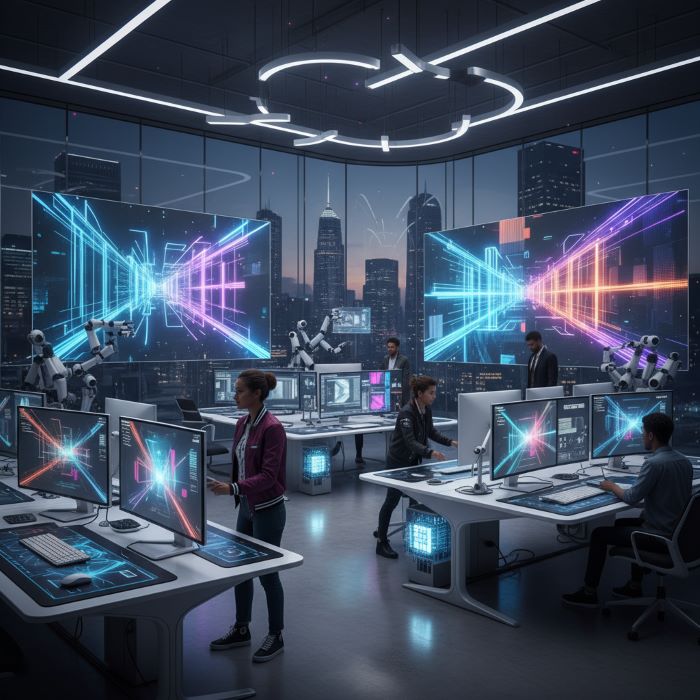AI and Generative Design in the Future of Architectural Lighting
The convergence of artificial intelligence and generative design technologies is fundamentally transforming architectural lighting practice, creating unprecedented opportunities for innovation, optimization, and creative exploration. AI generative design architectural lighting applications enable designers to explore vast solution spaces while optimizing multiple performance criteria simultaneously, resulting in lighting solutions that surpass traditional design approaches in both performance and creative sophistication.
Understanding Generative Design Principles in Lighting Applications
 Generative design represents a paradigm shift from traditional design approaches where designers create individual solutions toward computational processes that generate multiple design alternatives based on specified performance criteria, constraints, and objectives. In lighting applications, these systems can simultaneously optimize energy efficiency, visual comfort, aesthetic quality, and cost considerations while exploring design possibilities that might not occur to human designers working within conventional frameworks.
Generative design represents a paradigm shift from traditional design approaches where designers create individual solutions toward computational processes that generate multiple design alternatives based on specified performance criteria, constraints, and objectives. In lighting applications, these systems can simultaneously optimize energy efficiency, visual comfort, aesthetic quality, and cost considerations while exploring design possibilities that might not occur to human designers working within conventional frameworks.
AI generative design architectural lighting systems leverage machine learning algorithms that can analyze vast databases of successful lighting installations while identifying patterns and relationships that inform new design generation. These systems learn from precedent projects while incorporating advancing technology capabilities and changing performance requirements that reflect contemporary design challenges and opportunities.
The integration of parametric design tools with artificial intelligence enables sophisticated optimization processes that adjust lighting system characteristics including fixture placement, optical specifications, control strategies, and integration approaches based on real-time analysis of performance outcomes against specified design objectives and constraints.
Machine Learning Applications in Lighting Performance Optimization
Machine learning algorithms excel at identifying complex patterns in lighting performance data that enable more precise prediction of how different design decisions will affect overall system effectiveness, user satisfaction, and energy consumption throughout varying operational conditions and usage patterns. These capabilities enable designers to make more informed decisions while exploring design alternatives with greater confidence in predicted outcomes.
Daylight analysis and artificial lighting coordination benefit significantly from machine learning approaches that can predict optimal integration strategies based on site-specific conditions, building geometry, and intended use patterns. These systems can analyze weather data, solar angles, and occupancy patterns while generating lighting control strategies that maximize daylight utilization while maintaining consistent illumination quality.
Energy consumption optimization through machine learning enables lighting systems that adapt automatically to usage patterns while identifying opportunities for efficiency improvements that might not be apparent through traditional analysis methods. These systems learn from actual building operation while continuously refining performance to achieve optimal energy utilization without compromising user satisfaction or functional requirements.
Computational Design Tools and Workflow Integration
Advanced computational design platforms integrate artificial intelligence capabilities with traditional design tools while providing designers with enhanced capabilities for exploration, analysis, and optimization throughout design development processes. These integrated workflows enable more sophisticated design exploration while maintaining creative control and design intent throughout AI-assisted design processes.
Building Information Modeling (BIM) integration with AI generative design tools enables comprehensive analysis of lighting system integration with architectural, structural, and mechanical systems while automatically identifying potential conflicts and optimization opportunities. These integrated approaches support more efficient design development while ensuring better coordination between different building systems.
Real-time performance feedback during design development enables immediate evaluation of design decisions while supporting iterative refinement of lighting solutions based on quantitative performance analysis and qualitative design objectives. These responsive design tools enable more informed decision-making while accelerating design development timelines.
Automated Lighting Layout and Fixture Selection
AI systems can generate optimal lighting layouts that consider multiple factors simultaneously including illumination requirements, energy efficiency, installation costs, maintenance accessibility, and aesthetic integration while exploring configuration options that optimize overall system performance beyond what traditional design approaches typically achieve.
Fixture selection algorithms can evaluate thousands of product options while considering performance specifications, cost factors, availability, and compatibility requirements that enable optimal equipment selection for specific applications. These systems can continuously update recommendations as new products become available while ensuring selections remain current with advancing technology.
Control system integration and programming can be optimized through AI approaches that generate control strategies based on intended usage patterns, occupancy characteristics, and performance objectives while ensuring intuitive operation for building users and facility management personnel throughout system operational life.
Predictive Performance Modeling and Simulation
Advanced simulation capabilities powered by artificial intelligence enable more accurate prediction of lighting system performance under various operational conditions while accounting for factors including weather variations, occupancy patterns, maintenance schedules, and aging characteristics that affect long-term performance outcomes.
Digital twin applications for lighting systems provide ongoing performance monitoring and optimization while enabling predictive maintenance approaches that anticipate component failures and performance degradation before they affect system operation or user satisfaction. These systems support proactive facility management while optimizing long-term system reliability and cost-effectiveness.
Scenario analysis and design alternative evaluation through AI-powered simulation enable comprehensive assessment of different design approaches while quantifying performance differences and trade-offs between alternative solutions. These capabilities support more informed design decision-making while enabling optimization across multiple performance criteria simultaneously.
Personalization and Adaptive Lighting Systems
Artificial intelligence enables lighting systems that learn from individual user preferences and behavior patterns while automatically adjusting illumination characteristics to optimize comfort, productivity, and satisfaction for specific occupants throughout changing daily and seasonal conditions. These personalized lighting approaches represent significant advances over traditional one-size-fits-all lighting design.
Biometric integration and physiological monitoring enable lighting systems that respond to real-time indicators of occupant comfort, alertness, and wellbeing while adjusting illumination characteristics to support optimal performance and health outcomes. These responsive systems require careful consideration of privacy and data security while providing unprecedented capabilities for human-centric lighting design.
Collaborative spaces benefit from AI systems that can balance individual preferences with group needs while maintaining appropriate illumination for different activities and collaboration styles throughout varying occupancy and usage patterns. These intelligent systems support diverse work styles while maintaining overall environmental quality and energy efficiency objectives.
Design Exploration and Creative Enhancement
AI generative design tools enhance rather than replace human creativity by enabling designers to explore much broader solution spaces while providing rapid feedback about performance implications of different design decisions. These tools support more adventurous design exploration while ensuring that creative concepts can be realized effectively within practical constraints.
Style transfer and aesthetic optimization algorithms can apply design languages and aesthetic preferences to lighting solutions while maintaining performance requirements and technical constraints. These capabilities enable consistent design development across large projects while supporting individual creative expression within established design frameworks.
Inspiration and precedent analysis through AI systems can identify relevant design examples and successful solutions from vast databases of architectural lighting projects while highlighting design strategies and technical approaches that may inform current design challenges and opportunities.
Integration with Smart Building Ecosystems
AI generative design architectural lighting systems increasingly integrate with broader smart building platforms while contributing to comprehensive building intelligence that optimizes multiple building systems simultaneously. These integrated approaches create synergistic benefits that exceed the sum of individual system optimizations while supporting building-wide performance objectives.
Internet of Things integration enables lighting systems to participate in comprehensive building data collection while providing information that supports broader building management and optimization efforts. These connected systems support both immediate operational efficiency and long-term performance optimization through comprehensive data analysis and machine learning applications.
Cybersecurity and data protection considerations become increasingly important as lighting systems become more connected and intelligent while collecting detailed information about building usage patterns and occupant behavior. Security frameworks must balance system capabilities with privacy protection and network security requirements throughout system operational life.
Professional Practice Evolution and Skill Development
The integration of AI and generative design tools in architectural lighting practice requires professional development and skill enhancement that enables designers to leverage these powerful tools effectively while maintaining design quality and project management capabilities. These evolving practice requirements create opportunities for enhanced design capabilities while requiring ongoing professional learning and adaptation.
Collaboration between human designers and AI systems requires new approaches to design process management while ensuring that artificial intelligence enhances rather than replaces human creativity and professional judgment. Effective integration of AI tools requires understanding of both capabilities and limitations while maintaining appropriate oversight of automated design processes.
Quality control and design validation procedures must evolve to address AI-generated design solutions while ensuring that automated systems produce results that meet professional standards and project requirements. These validation processes require both technical verification and design quality assessment throughout AI-assisted design development.
Regulatory and Standards Compliance
AI generative design systems must incorporate building codes, accessibility requirements, and industry standards while ensuring that generated solutions comply with applicable regulations without requiring extensive manual verification and modification. Automated compliance checking enables more efficient design development while reducing risks of non-compliance throughout complex regulatory environments.
Professional liability and responsibility considerations require clear understanding of how AI-generated designs affect professional accountability while ensuring appropriate oversight and validation of automated design processes. Insurance and risk management frameworks must evolve to address these changing practice models while maintaining appropriate protection for both designers and building owners.
Documentation and design communication requirements may need modification to address AI-generated solutions while ensuring that design intent and system performance expectations are clearly communicated throughout project development and construction phases.
Economic Impact and Market Transformation
The adoption of AI generative design architectural lighting tools is likely to transform market dynamics while affecting project costs, timelines, and competitive advantages throughout the lighting design industry. Early adopters may gain significant competitive advantages while the broader industry adapts to these advancing capabilities and changing client expectations.
Return on investment for AI design tool adoption requires careful consideration of technology costs, training requirements, and productivity improvements while evaluating long-term benefits including enhanced design capabilities, improved project outcomes, and competitive positioning in evolving market conditions.
Client expectations and service delivery models may evolve as AI capabilities become more widespread while creating opportunities for enhanced design services and improved project outcomes that justify investment in advancing technology and professional development throughout lighting design practice.
Future Development and Emerging Opportunities
Quantum computing applications may eventually enable even more sophisticated optimization capabilities while supporting real-time analysis of extremely complex lighting design problems that currently require significant computational time and resources. These advancing computational capabilities promise to further enhance AI generative design possibilities while enabling analysis of previously intractable design challenges.
Augmented reality and virtual reality integration with AI design tools will likely enable immersive design exploration and client communication while providing immediate visualization of AI-generated design solutions in realistic environmental contexts. These visualization capabilities will support better design decision-making while enhancing client engagement throughout design development processes.
Autonomous design systems that require minimal human intervention may eventually emerge while enabling rapid generation of complete lighting solutions for standard building types and applications. These systems could dramatically reduce design development time while ensuring consistent quality and performance for routine projects.
The integration of artificial intelligence and generative design in architectural lighting represents a fundamental transformation in design practice that promises to enhance both creative capabilities and technical performance while creating new opportunities for innovation and optimization. The most successful implementations will be those that thoughtfully integrate these powerful tools with human expertise and creative vision while maintaining focus on creating lighting environments that truly serve human needs and architectural objectives.































